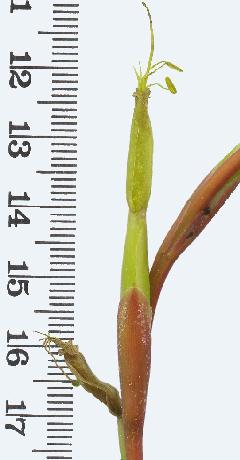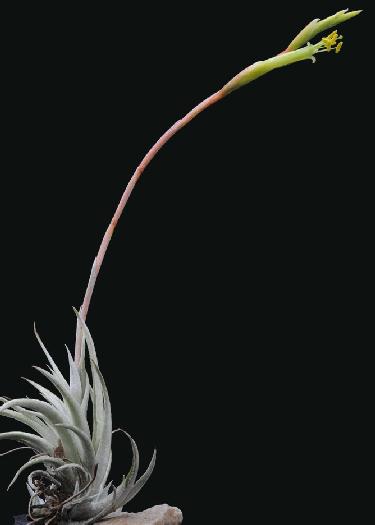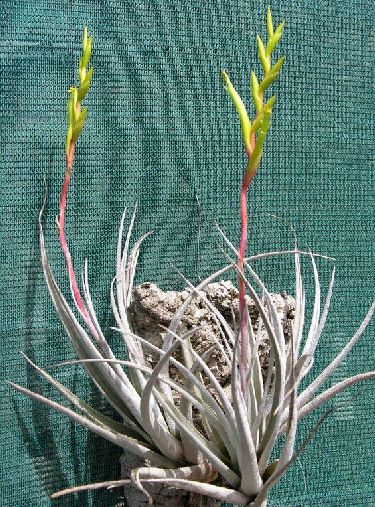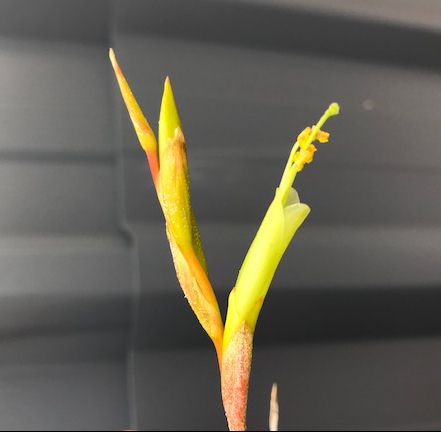






Derek Butcher ... "Ray Clark: Congratulations. I suppose you would have noticed the subtle difference between it and karwinskyana.
- 5. Floral bracts abaxially glabrous, with a rounded tip; flowers adpressed to the rachis. Nuevo Leon, San Luis Potosi => karwinskyana.
- 5. Floral bracts sparsely lepidote abaxially, with an acute or obtuse tip; the flowers are slightly separated from the rachis. Zacatecas, Jalisco => fresnilloensis
It must be 10 years ago when I got involved with translating Juan Pinzon's work on the T. utriculata complex. You may be interested that I am one of the listed authors of a 69 page paper which went to the publisher 3 months ago. Perhaps the New Year wil see some action."
Ray Clark ... " to be honest, I have not flowered T. karwinskyana yet and more pertinently I didn’t give it much thought until after I posted.
Reading the word document from the DVD, I note that Renate had many karwinskiyana and had trouble differentiating between them and fresnillinoensis. She also went on to say that Sue Gardner raised the issue as well and a few others have tried to clarify the problem but it sounds as if nothing concrete has come of it.
Does the published article that you mention address this? That would be nice to see and it may validate Renate’s thoughts as she went on to say that even though it was difficult, there were a lot of differences. I am not sure how unusual it is but I haven’t seen any soft grey Tillandsias in my collection flower with a green / yellow combination."
Derek Butcher ... "The T. utriculata group is an interesting one that Renate was keenly interested in and published new species. Juan Pinzon in 2012 did his Doctorate but only published new species. He asked me to hang on to his views on all the other species and I have had itchy fingers ever since. Juan then went to work with Walter Till on that monumental Tillandsioideae project. He is now back in Mexico keen to get his T. utriculata group published. This discussion group was involved in the early stages especially Mark Supple so it is not just me that is anxiously waiting publication."
Mark Supple ... " I wish I still had the original I recieved from Derek, but dropbox deleted it unfortunately, I'd love to see it again, even in Spanish you could still read parts of it. Good to see it will be published and everyone can see."
Derek Butcher ... "Sure is a tangled web. I still don't know how you got the plant or lost it. I have a feeling it may have been linked to Renate's interpretation as to T. cucaensis. I also enclose a photo of T. izabalensis to remind you of the past."
Mark Supple ... "The plant is still in Newcastle at Gordon Slack's place, he imported it in the 80's from a now long gone nursery in Guatemala, I did send all those details to Juan way back then, funny I pulled the plant apart at Gordon Slack's and Len Colgan was there, he couldn't agree with me that it was different in many ways from everything that was described at the time. I should pull my finger out and start pulling more plants apart that don't look right with the attached label. I still have pictures of the flower etc I pulled apart on file."
Derek Butcher ... "Interesting that your photo gets in but not a mention in paratypes. Perhaps collection data in Guatemala was too vague. If you have a couple of photos of T. izabalensis you would like to be on the DVD please send them."
Tillandsia fresnilloensis Weber & Ehlers, Sp nova, Feddes Repert. 94:609-11. (1983)
A Tillandsia albida Mez et Purpus 1916 cui affinis, planta acaulis, bracteis floralis et sepalis lanceolata-acuminatis differt.
Planta florens usque ad 22cm longa, basi copiose prolifera. Folia rosulam erecta vel subsecunda formantia, utrimque pruinose albo-lepidota. Vaginae indistincte limitatae, triangulate-ovales, usque ad 25mm longae, 20 mm latae, rugosae. Laminae anguste triangulatae, usque ad 9cm longae, medium 10 mm latae, subulate acuminatae, valde canaliculatae. Scapus usque ad 12 cm longus, teres, 2mm diametiens, dilute purpureus, glaber, internodia 20-25 mm longa. Bracteae scapales lanceolatae, minute apiculatae, erectae, stramineae, nervatae, disperse appresso-lepidotae ve1 subglaber, internodiis paulo superans. Inflorescentia simplex, Iaxe pauciflora (3-flora), rhachis valde geniculatis. Flores breviter (5 mm) crasse stipitati ca. 40 mm longi, ab axi divergenti. Bracteae florales; ovate lanceolatae, minute apiculatae, 20-23 mm longae, 10 mm latae, nervatae, ecarinatae, hyalino-marginatae, glaber, breviora quam sepala. Sepala usque ad 25 mm longa, lanceolata, usque ad 2,5 mm aequialto-connata, glabra, hyalino-marginata. Petala ignota (virescenti-albida Ehlers!)
Habitat: Mexico, Zacatecas, vic. Fresnillo, leg, Renate Ehlers s. n. Martius 1981, Holotypus: WEB 293.
Translated from German by Butcher
Plant flowering to 22cm long and with many offsets at the base.
Leaves many, making an erect secund rosette, both sides white pruinose scales.
Leaf sheath triangular oval, indistinct, to 25mm long, 20mm wide, when dry strongly wrinkled.
Leaf blade thin triangular, to 9cm long, in the middle to 10mm wide, acuminate, strongly grooved.
Scape to 12cm long, round, 2mm diam, smooth, weak purplish tint, internodes 20 – 25mm long.
Scape bracts lancelike, fine apiculate, erect, straw coloured, nerved, scattered appressed scales, to almost smooth, exceeding the internodes a little way.
Inflorescence simple, few flowered (3 -), rhachis strongly geniculate.
Flower ca 40mm long, with thick stem, spreading out.
Flower bract oval lancelike, 20 – 23mm long, 10mm wide, nerved, not keeled, smooth, with transparent edges, shorter than the sepals.
Sepals to 25mm long, lancelike, joined for 2.5mm, not keeled but with very fleshy midnerve, with transparent edges.
Petals greenish white. (Ehlers!)
Type Mexico, Zacatecas, in vicinity of Fresnillo. leg. Renate Ehlers s n , March 1981, Holotype WEB 293
Differs from T. albida in.
1. Plant stemless
2. Bracts lanceolate-acuminate
3. Sepals lanceolate-acuminate
T. fresnilloensis has a relationship with T. karwinskyana. It is distinguished by its being larger.
Notes from R Ehlers 1/1994.
I have a lot of karwinskyana and I find it pretty difficult to solve the problem Sue Gardner wrote about. I have plants looking like karwinskyana with the stamens (?style) fitting utriculata. Weber made the description of T. fresnilloensis at a time when he was the “expert” and asked my opinion before publishing. Of course the differential diagnosis should have been done with T. karwinskyana not with T. albida and the question is whether it is a good species because it is very close to karwinskyana. It flowered in the meantime several times in our collection. So I thought it would be good to make it a synonym of T. karwinskyana. But going on with the studies there are a lot of differences. Also in other plants we found in the meantime near Guadalajara and others near San Juan Capistrano, but it would mean a lot of work and time, which I do not have at this moment. So the problem is in the drawer at the moment.